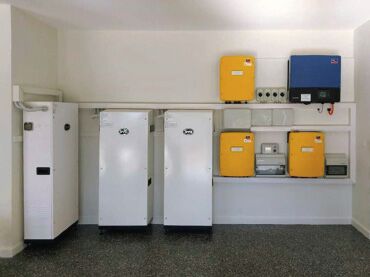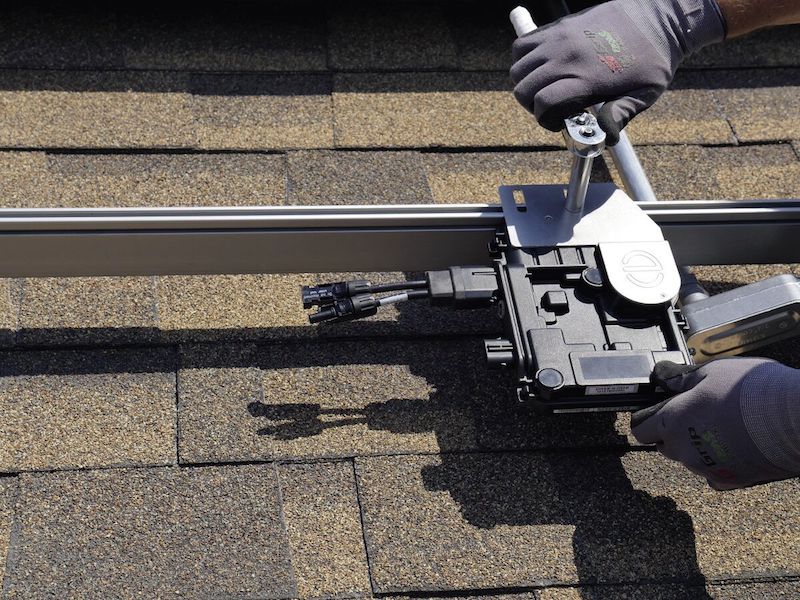Touted to hold the potential of becoming the world’s first mass market for battery storage, Australia has always been big on taking full advantage of solar energy generated by small-scale installations. According to data released by the Clean Energy Regulator several weeks ago, Australia’s total installed small-scale renewable energy capacity reached 6 GW, of which 5.9 GW came from PV panels installed on homes and businesses, as markets in every state continued to deliver the best year to date, with a total of 568 MW installed in the first half of 2017.
This comes as good news for storage installers, bearing in mind that, in addition to retrofitting existing systems, another powerful force in the current market is the early adopters of solar+storage, whose numbers are growing at a clip. According to the findings of Australian solar consultancy SunWiz, 5% of all new systems installed in 2016 were equipped with battery storage, whereas this year is expected to see that figure soar to 15%. Altogether, the consultancy expects up to 30,000 new battery systems to be plugged in this year, whereas IHS Markit sees the same number reached by 2018. In one of the latest reports by the Australian Energy Market Commission, which shied away from the previously proposed imposition of charges for exports of energy from distributed solar generators, it is said that by 2036-37 that residential and commercial battery storage uptake will exceed 5.5 GW.
AT A GLANCE
- Australia boasts the highest PV penetration rate per capita in the world, with more than one in five homes and businesses now equipped with solar panels.
- Distributed storage deployment figures are rising fast, and while some manufacturers are satisfied, others say that the market is growing more slowly than expected.
- All of the storage providers that pv magazine contacted report strong sales Down Under.
- Predicted average battery capacity on Australian soil has exceeded expectations, going up to 10 kWh.
- Storage manufacturers are fully confident of their technologies in the face of Standards Australia’s installation guidelines.
Although a number of storage developers have laid a lack of initiative for the technology’s further deployment at the door of regulators and federal officials, action at the state and territorial level has been vigorous.
The Climate Council’s recent report, Renewables ready: States leading the charge, released earlier this month, shows that states and territories are now focusing on energy storage as a key element underpinning the shift to higher levels of renewable energy. The Northern Territory, Australian Capital Territory, South Australia, Victoria, and Queensland have rolled out or are planning to introduce battery storage to provide greater grid security, while South Australia is preparing to welcome the world’s largest lithium-ion battery storage facility
(100 MW/129 MWh) by December 2017. But looking at the bigger picture from the viewpoint of manufacturers, is the market actually living up to expectations?
Projection versus actual
Commenting on their impressions of the development of Australia’s distributed storage market, a number of prominent suppliers point to the vast potential of the marketplace. South Korea’s LG Chem is among those who are nevertheless satisfied by the market. It highlights not only the residential market’s growth rate, but also the increase in the predicted average storage capacity from 6.5 kWh, with a growing number of users opting for 8-10 kWh systems to maximize their self-consumption. Also, the German battery supplier sonnen says that the situation in the Australian market is better than expected, attributing this to the big local appetite for battery storage, and this year’s launch of its sonnenFlat, which, according to company sources, is far exceeding expected demand.
There are, however, those who see things differently. “Comparing projections to actual results is difficult in a market where no true data are available. That being said, it would be fair to say that the residential energy storage market isn’t growing as quickly as what the industry had predicted it will be,” Nathan Dunn, Enphase Energy Managing Director for Asia Pacific, tells pv magazine, noting that the company still sees opportunities for growth in the market driven by retrofitting, which currently makes up more than half of its new storage installations.
Sharing this viewpoint, German inverter manufacturer SMA believes that the residential storage segment is developing a little more slowly than expected, but steadily and sustainably. On the other hand, commercial storage is only just beginning to take off, and that is where the company sees strong potential.
Furthermore, for China’s BYD, the Australian storage market is still in its infancy, and looking back on H1 2017, the company believes it is also not thriving as rapidly as anticipated.

Photo: BYD
“A lot of people are talking about residential storage, and seeing this as big potential. From my point of view, it is not booming yet, as the price is still relatively high and people are actually not really aware of the lithium battery,” says Joey Qiao, Business Development Manager at Chinese electric vehicle and battery storage company BYD. Qiao adds that next year prices will be lower, and the appetite for storage will grow stronger.
However, when discussing the drivers behind battery storage adoption Down Under, providers are unanimous in pointing to the desire for self-consumption amid utility price hikes. This year alone has seen power prices go up by as much as 20%. Bill shock stands out as the biggest motivation behind the adoption of battery storage in Australia.
“With the current electricity prices in Australia, the investment in a storage system can already be amortized after four to five years,” says Stephan Weimann of sonnen. He adds that alongside financial reasons, the company has recognized a big role played by ideological motivations, with its customers becoming increasingly interested in achieving green self sufficiency. In addition, storage providers identify backup power as another important reason behind the Australian market uptick, with the goal of avoiding dramatic voltage swings and major blackouts, such as the one last summer that hit almost the entire state of South Australia, or power supply shortages that regularly affect small pockets of the population. But the list of possibilities offered by storage goes on.

“The regulatory and business ecosystem of Australia creates an opportunity for interesting applications of energy storage that benefit both system owners and grid stakeholders. This is what we anticipate will drive Australia’s solar and smart energy management market in the coming years,” says Lior Handelsman, SolarEdge VP, Marketing and Product Strategy, adding that the distributed storage market is beginning to mature with educated installers and a range of quality solutions now available.
Growing figures
Due to its unique combination of the highest irradiation and highest amount of PV per capita in the world, coupled with frequently increasing electricity tariffs and power supply instability, Australia has always been recognized as fertile soil for storage. Moreover, the expiration of some premium solar FITs this year, particularly in New South Wales, but also in Victoria and South Australia, is predicted to push the battery deployment rate even higher. So far, figures show nothing but an upward trajectory.
“Our first deliveries in Australia took place in November 2016. By February/March 2017, 500 sonnen batteries were installed. We expect around 2,500 installations by the end of 2017,” Stephan Weimann, spokesperson for the company, told pv magazine.
As many of the storage providers now active in Australia penetrated the marketplace only this year, they speak of higher sales than anticipated. This goes for BYD, which earlier this year launched its B-Box product range, with plans to grab a sizable share of the country’s battery market.
“We actually realized the first delivery in Australia in April 2017, and by the end of June, we had sold around 2,000 B-Plus 2.5 battery modules with 5 MWh of capacity. We have strong sales in Australia at the moment,” said Qiao.
Meanwhile, Israeli power electronics specialist SolarEdge has seen particularly strong interest from commercial businesses in installing solar+storage systems. It says that such systems reduce excess usage charges, which are particularly high for businesses using heavy machinery, but can also halve a company’s energy bills by means of load shifting. It’s a similar story for other key market players.
“We can confirm that we have increased our residential battery sales in Australia by over 400% compared to last year, and also our average system size is now 9.1 kWh full capacity,” says Jamie Allen, LG Chem’s Business Manager Australia & Pacific, adding that LG Chem sees the next couple of years being a strong period of growth in Australia for the ESS market.
However, it is the technology’s price that still has the biggest impact on the pace of adoption. Storage providers agree that there are many customers that are still reluctant to install storage systems as they wait for further price declines, and therefore many of them see 2018 as the milestone year for the Australian storage sector. Another buzzword is payback.
“Many of the early adopters have already taken to batteries, and the next level of homeowners will jump on the storage bandwagon when they see the financial benefits before making a commitment. The market still doesn’t think that a 7 to 8-year payback period is good enough. We feel that homeowners are waiting to see a payback period of 3 to 5 years before they will commit to purchase, and this is what the tipping point will be for storage,” said Dunn, adding that Enphase has already seen an uplift in enquiries for its AC Battery, which is set to translate into sales for the rest of the year.
Yin and yang
Idling in the background of the Australian storage market’s stellar growth is the Draft Battery Standard ASNZ5139, which would ban the installation of lithium-ion battery storage systems inside homes and garages, labelling them a fire risk.
Back in February, Standards Australia aired the guidelines for the first time, provoking the industry’s backlash. However, just weeks ago, the Sydney-based organization recently wrapped up a public consultative process, under which it received more than 3,000 comments on the draft. It decided to temporarily pause the efforts to introduce new rules. As the initial outcry over the possible requirement for storage systems to be installed in separate kiosks or bunkers has subsided, suppliers now appear cool-headed.
“The proposed draft standard seems like it will need to be revised to fall in line with international battery safety experience so consumers can have the safest, best value, and highest quality battery products,” said Allen of LG Chem.
Stressing that their lithium-ion batteries go through extensive international standard tests that ensure their safety and efficiency in harsh climate conditions, storage providers say that they do not see potential new rules as a challenge. Moreover, they pledge to continue to work with the Clean Energy Council in advocating for installation standards with homeowner safety in mind.
“While the new draft regulations may make business and installations complex in Australia, there is a precedent for the market being able to find a balance of maintaining superior safety levels, while also keeping costs down,” said Handelsman of SolarEdge.
According to Standards Australia’s latest release on the matter, the organization will continue to cooperate with key stakeholders, in the hope of getting the necessary guidance for its technical committee. But whether the potential inconvenience is completely gone or not, it is yet to become clear. Meanwhile, leading storage companies look confident of their technologies and are determined to further consolidate their market shares amid tightening competition and rising expectations.
This content is protected by copyright and may not be reused. If you want to cooperate with us and would like to reuse some of our content, please contact: editors@pv-magazine.com.

